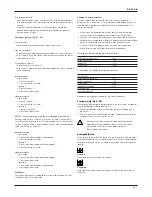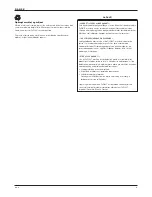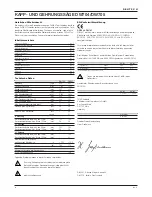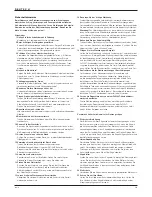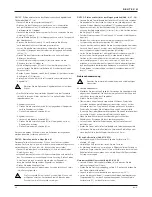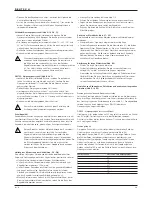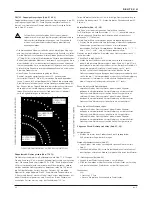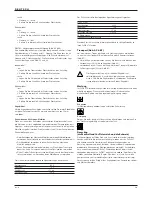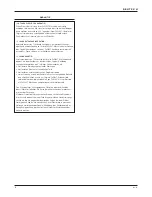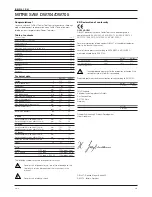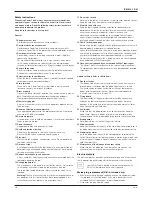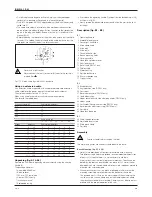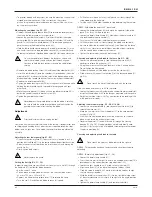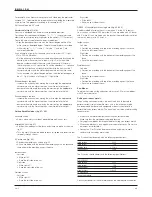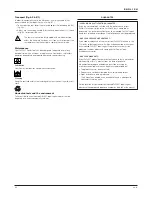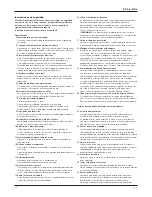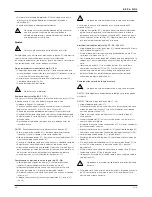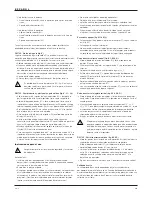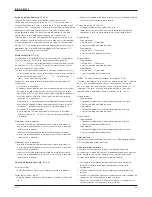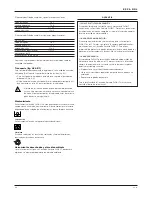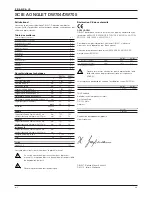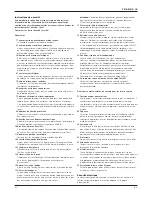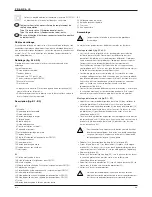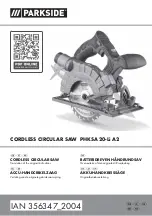
E N G L I S H
21
en - 4
• Pull the saw arm down as far as it will go and cut slowly through the
scrap wood and the kerf plate.
• Turn the saw OFF and allow the blade to stop before raising the saw arm.
DW705 - Widening the kerf for 45° bevel cuts
• Loosen the clamping knobs (23) and move the upper left side of the
fence (7) as far as it will go to the left.
• Loosen the bevel clamp handle (21). Now adjust the bevel angle to 45°
and lock the bevel clamp handle (21).
• Turn the saw ON and allow the blade to reach full speed.
• Pull the arm down and cut slowly through the wood and kerf plate.
• Be sure to adjust the left side of the fence (7) (see “Adjusting the fence”)
so that it is as close to the saw blade as possible without interfering
with the up and down movement of the arm.
• Tighten the fence in position using both knobs (23).
Checking and adjusting the blade to the fence (fig. G1 - G4)
• Loosen the mitre clamp knob (4) and squeeze the mitre latch (5)
upwards to release the mitre arm (47).
• Swing the mitre arm until the latch locates it at the 0° mitre position.
Do not tighten the clamp knob.
• Pull down the head until the blade just enters the saw kerf (45).
• Place a square (48) against the left side (7) of the fence and blade (41)
(fig. G3).
Do not touch the tips of the blade teeth with the square.
If the saw blade is not exactly at 90° to the fence:
• Loosen the three screws (49) and move the scale/mitre arm assembly left
or right until the blade is at 90° to the fence as measured with the square.
• Retighten the three screws (49). Pay no attention to the reading of the
mitre pointer at this point.
Adjusting the mitre pointer (fig. G1 - G3, H1 & H2)
• Loosen the mitre clamp knob (4) and squeeze the mitre latch (5) to
release the mitre arm (47).
• Move the saw arm to set the mitre pointer (51) to the zero position,
as shown in fig. H1.
• With the mitre clamp knob loose, allow the mitre latch to snap into
place as you rotate the mitre arm past zero.
• Observe the pointer (51) and mitre scale (6) through the viewing
opening (52) (fig. H2). If the pointer does not indicate exactly zero,
gently pry it left or right using a flat bladed screwdriver at either end of
the plastic moulding (53).
Checking and adjusting the blade to the table
Do not touch the tip of any blade teeth with the square.
DW704 - This machine has been factory set and should not require
adjusting
DW705 - Bevel stop adjustment (fig. J1 - J8)
• Loosen the bevel clamp handle (21).
• Press the mitre arm to the right to ensure the angle position stop (19) is
located against the vertical position stop adjustment (25).
• Loosen the right hand lock nut (54) and screw in the stop (25).
• Align the notches (61) in the bevel housing and table as shown.
• Place the smooth end of a 6.35 mm drill bit into the notches to align
the two housings together.
• While the drill bit is in the notches (61), turn the right bevel stop screw
(25) counterclockwise until it is firmly in contact with the angle position
stop (19).
• Tighten the bevel clamp handle (21) and remove the drill bit.
• To prevent binding and inaccuracy, be sure the mounting surface is not
warped or otherwise uneven. If the saw rocks on the surface,
place a thin piece of material under one saw foot until the saw is firm
on the mounting surface.
Mounting the saw blade (fig. D1 - D7)
• Depress the head lock up release lever (10) to release the lower guard (2),
then raise the lower guard as far as possible.
• Loosen the guard bracket screw (35) sufficiently to allow the angled
corner piece (36) to pass between the head of the screw (38) and the
guard. This will allow the guard bracket (37) to be raised enough to
permit access to the blade locking screw (39).
• Hold the lower guard up and depress the spindle lock button (15) with
one hand, then use the supplied blade spanner (18) in the other hand
to loosen the left-hand threaded blade screw (39) by turning clockwise.
To use the spindle lock, depress the button as shown and
rotate the spindle by hand until you feel the lock engage.
Continue to hold the lock button in to keep the spindle from
turning.
• Remove the blade locking screw (39) and the outside arbor collar (40).
• Install the saw blade (41) onto the shoulder (42) provided on the inside
arbor collar (43), making sure that the teeth at the bottom edge of the
blade are pointing toward the back of the saw (away from the operator).
• Replace the outer arbor collar (40).
• Tighten the blade locking screw (39) by turning counter-clockwise while
holding the lower guard up and the spindle lock engaged with your
other hand.
• Move the guard bracket (37) down until the angled corner piece (36) is
below the head of the guard bracket screw (35).
• Tighten the guard bracket screw.
Never depress the spindle lock pin while the blade is rotating.
Be sure to hold the guard bracket down and firmly tighten the
guard bracket screw after installing the blade.
Adjustment
Prior to adjustment always unplug the tool.
Your Mitre Saw was accurately adjusted at the factory. If readjustment due
to shipping and handling or any other reason is required, follow the steps
below to adjust your saw. Once made, these adjustments should remain
accurate.
Adjusting the rear lower guard (fig. E1 - E3)
• Check the rear lower guard (11) to ensure that it is located in such a
position that the blade (41) is in the centre and equidistant from each side.
• Adjust as necessary by loosening the two screws (44) and moving the
guard (fig. E2).
• Firmly tighten both screws.
Never remove the guard.
Cutting the kerf (fig. B2, F1 - F4)
In order to adjust and use your Mitre Saw, you must cut a slot (45) through
the kerf plate (27) to allow for blade clearance.
• Set the saw at 0° mitre.
• Place a piece of scrap wood on the saw; the size should be at least
25 mm x 152 mm x 305 mm (46).
• Depress the head lock up release lever (10) to release the head.
• Turn the saw ON and allow the blade to reach full speed.

